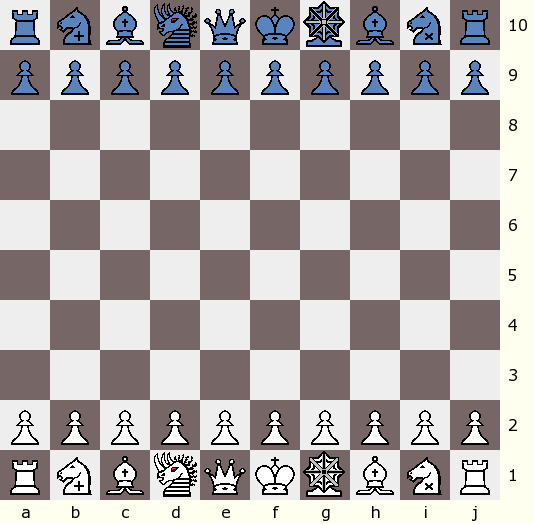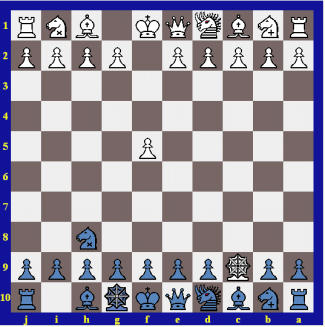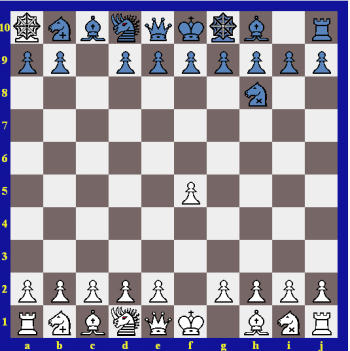Venomous
Venomous features 2 new exotic pieces that possess unusual moving abilities: : the Sissa and the Sorcerer Snake. The game also uses augmented knights instead of regular knights, and 5 special pawns (Ninja Pawns) can be dropped during play.
The new pieces are:
The Sissa: - A powerful slider which moves strangely: an equal number of squares as a rook and a bishop.
This piece was invented by Carlos Cetina.
The Sorcerer Snake: A piece that follows one of two crooked paths to squares that are a Knight's move away or an extended Knight's move away.
The Ninja Pawn:- A stronger pawn can also move sideways anywhere and capture sideways on the enemy half of the board.
The Ninja Pawn is not present in the intial setup but is dropped during play into a vacant space on the second rank.
It can be optionally pushed forward on the same turn.
The Knights are replaced by the Ferz-Knight and the Wazir-Knight which make additional diagonal or orthogonal stepping movements.
Otherwise, the rules are exactly as in orthodox chess except for: Flexible castling (King can castle by moving 1, 2 or 3 (or 4 on Q-side) spaces towards rook, modified movement of the standard pawns and associated extended en-passant rules.
Board Setup
 |





|
|
The board is set up as follows for the white side (black side will mirror this):
Rook on a1 Wazir Knight on b1 Bishop on c1 Sorcerer Snake on d1 Queen on e1 King on f1 Sissa on g1 Bishop on h1 Ferz Knight on i1 Rook on j1 10 pawns from a2 to j2. Note that the lower right square is white, and that kings occupy the same color square. 5 Ninja pawns to be dropped one per turn into empty space from a2-j2 |





|
Pieces and movement
The Sorcerer Snake

 |
The Sorcerer Snake can go to the green squares by taking either 1 diagonal step followed by 1 orthogonally outward step
OR one orthogonal step followed by 1 diagonally outward step.
Since b3 is occupied by a black pawn, it cannot move there. The Sorcerer Snake can travel to blue squares by taking one orthognal step followed by 2 diagonally outward steps OR it can go to the same square by taking 2 diagonal steps followed by one orthogonally outwards. Both paths must be blocked for it not to be able to make it to the destination square. The pawn at b3 blocks one path to a2 and the pawn at b2 blocks the other, so it cannot get to a2. |
The Sissa
The Sissa can travel to destination squares by taking 1 or more diagonal steps like a bishop, then turn 45, 135, 225, or 315 degrees to take an equal number of orthogonal steps like a rook.
Or it can go 1 or more orthogonal steps as a rook, turn 45, 135, 225, or 315 degrees and then take equal number of diagonal steps.
The Sissa captures by replacement only. It cannot jump and must travel via vacant squares along the specified paths.
The pawn can move from its original position either 1, 2 or 3 vacant squares forward.
If it previously moved only 1 space originally or captured from original position, it can move forward two spaces towards the center.
En-passant is logically applied to meet these changes.
From the middle (rank 5 for white, rank 6 for black), it can step only 1 space forward into the upper half of board, but from thereafter it can go one or two vacant spaces forward.
For example, a pawn can start at e2 push forward to e5 then make one step to e6 then go e8, and promote at e10 in 4 moves!
Note that if a pawn makes the two step pawn move and bypasses an enemy pawn, it can be captured en-passant.
The Ninja Pawn


Movement:
The ninja pawn can always move 1 square up or 1 square sideways
to an empty square regardless of where it is situated on the board.
Thus White can on each turn move from e2-e3, e3-d3 and d3-d5.
From the middle exactly, (rank 5 for white, rank 6 for black), the ninja pawn can move only 1 square forward, but thereafter as soon as it enters enemy territory (the upper half of the board: White rank 6-10, and for black rank 5 - 1), the pawn can go forward either 1 OR 2 empty spaces.
Capture:
Like the standard pawn it can capture one square diagonally up, regardless of which half of the board it is on.
When the ninja pawn is on the top half of board (White rank 6 +, Black rank 5-) , it can also capture one square horizontally.
There is no en passant. It cannot capture another pawn or ninja pawn en passant nor can any other pawn capture it this way.
Promotion:
The ninja pawn promotes on the last row (rank 10 for white, rank 1 for black), to any piece. Promotion to a piece is mandatory so it would cease to be a pawn
in the last row.
Note that like the standard pawn, it can reach the promotion square from its start position in a minimum of 4 moves!
It cannot make a capture on the same turn as the drop.
The Ferz-Knight - moves like a knight or makes one step diagonally.
The Wazir-Knight - moves like a knight or makes one step orthogonally.
Play the Game
(You will need to register at chessvariants.org to play.)View Game Logs at chess variants.org for this game.
 Download Zillions of Games File
Download Zillions of Games File
About the New Game System and other thoughts
This chess system has been a work in progress. It contains other diverse games such as Wreckage, Octopus Chess and ZigZag Madness. It evolved from an earlier system that was used for games such as Birds and Ninjas. The system has the following characteristics:- A larger 10x10 board is used. The earlier system uses a 104 square board with two squares protruding from the center of each side. The larger board allows for a lot more possibilities, more pieces and a totally different feel.
- Flexible Castling - the King can castle in many different ways, by traveling one to 4 squares toward the rook. The choice of castling positions depends on the player's motivation: to tuck the king away in the wing or to use the rook to control an open center file.
- Augmented knights - the Wazir and Ferz Knights. These knights are far more powerful and deceptively so. Their power is often underestimated.
- Drop system. The drop system took some time to evolve to the current form.
Up to 5 Ninja pawns can be dropped unto an empty space in the second rank and optionally moved forward on the same turn.
It cannot however be dropped and then make a capturing move on the same turn, but it can deliver check immediately either by staying on the second rank or moving forward on the same turn.
In Wreckage, an extra piece: the Flying Guillotine can be dropped into an empty space in the back rank. However, piece drops in the back rank cannot be followed by an immediate move. Since the pieces dropped are normally quite powerful, this rule seems quite reasonable. - Ninja Pawns: These special pawns can move 1 space sideways and on the enemy half of board capture in this manner as well. Otherwise it moves the same as regular pawns except it cannot execute or be captured En Passant.
- Pawn Movement. Pawns and Ninja pawns can move forward multiple spaces toward the center on any turn regardless of how they moved earlier.
Thus, even if the pawn moves 1 space initially during one turn, it can still move forward two spaces to the center on the next turn.
From the middle they can only move 1 space forward to enter the enemy half of board.
The old system only allowed the pawns to move 1 space forward from then on, but in the new system the pawns can move 1 or 2 spaces in enemy territory! En Passant capture is extended for the pawns.
This makes the pawns much more powerful and capable of promoting very quickly.
It is imperative therefore to prevent the enemy pawns from entering your half of board. The ninja pawns gain more capturing powers and both pawns threaten to promote very quickly.
However, unlike other large board chess systems, the powers of the knights and pawns has not been diminished. In fact, pawn play may very well be more important in this system than in the orthodox chess system albeit in a different manner. The endgame of this chess system may very well be as rich if not richer than that of orthodox chess; - a claim that only a few other chess variants (or none at all) can seriously make.
It is the author's hope that other players would serve as pioneers and explore the new concepts of these games with an open mind. The key motivation has been to introduce games that are similar, yet with their own unique peculiar characteristics that set them apart from others.
Practical playability has also been a goal. Instead of boring the player with arcane references to complex, convoluted, and contrived theoretical jargon, the author has strived to simply create playable chess variants that would be at least as enjoyable as orthodox chess. Of course, history and categorization is important but who can seriously argue that the writers of history are in the same league as the makers of history? No one! Even an obscure chess variant inventor is more important than one who simply posts opinions!
The ultimate success of a chess variant is its playability. Right now orthodox chess is king in the western world, but the success of a chess-variant need not be correlated with the demise of this "Mad Queen" variant of chess.The author's motivation for using the Sissa in this system is twofold: firstly, it compliments the far weaker but quite interesting Sorcerer Snake, and secondly, (in the author's opinion) the Sissa has not been adequately explored in other chess systems.
Enjoy!An opening peculiarity
An interesting game I tried out with zillions went as follows. (The actual game had a few more irrelevant moves - I trimmed it down a bit to show the main idea.)

|
1. P f2-f5 // I opened with this move 1... .nf i10-h8 // Zillions playing black plays a non-descript move 2. S g1-c9 //I realized I can capture this pawn since it is undefended. This is a very important focal point in venomous. I had not realized earlier during previous games, that the Sissa actually struck this point. See diagram now. |
 |
2... .nw b10-c8 //this is the move that zillions should have played earlier to protect the pawn. 3. S c9-a10 //it seems now that I can capture the rook! 3... .nw c8-b10 //Surprise! My Sissa is trapped! see diagram now Regardles of what I play, black can capture my Sissa with its wazir knight on next turn winning the exchange. If I had not captured the rook, I could have withdrawn my Sissa and escaped. If I had done this, Black could possibly gain some tempo by attacking the Sissa with pawn moves or by developing the Sorcerer Snake. Whether this is adequate compensation for the pawn is unclear. e.g. S e9-e5 d10-b7 //attacking the Sissa with the Sorcerer Snake. |
|
If you would like to email the chess variant inventor directly: inventor@chess.computerwebservices.net
|
|
Posted by: test@test.net on 2009-06-13 12:02:08
This is great. |

